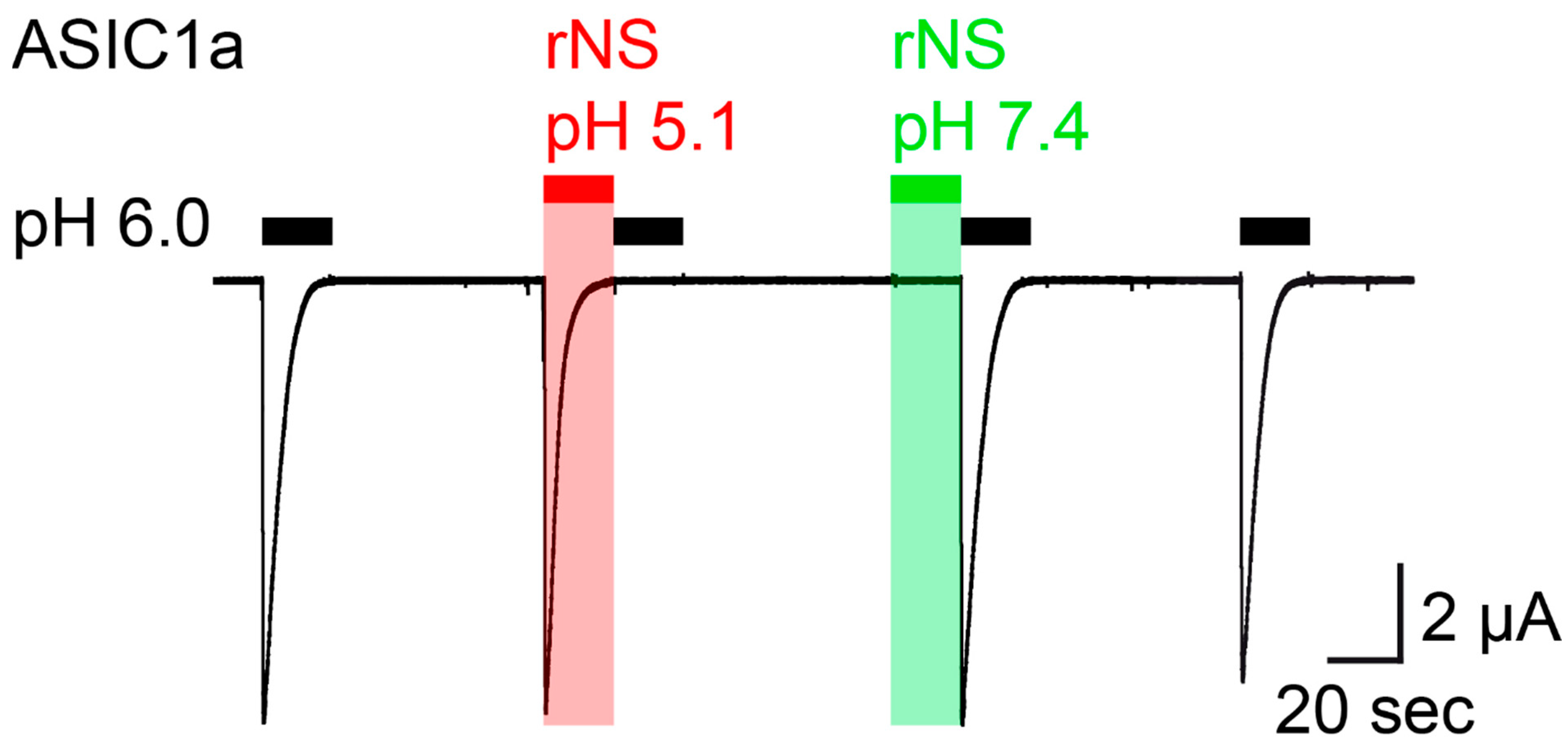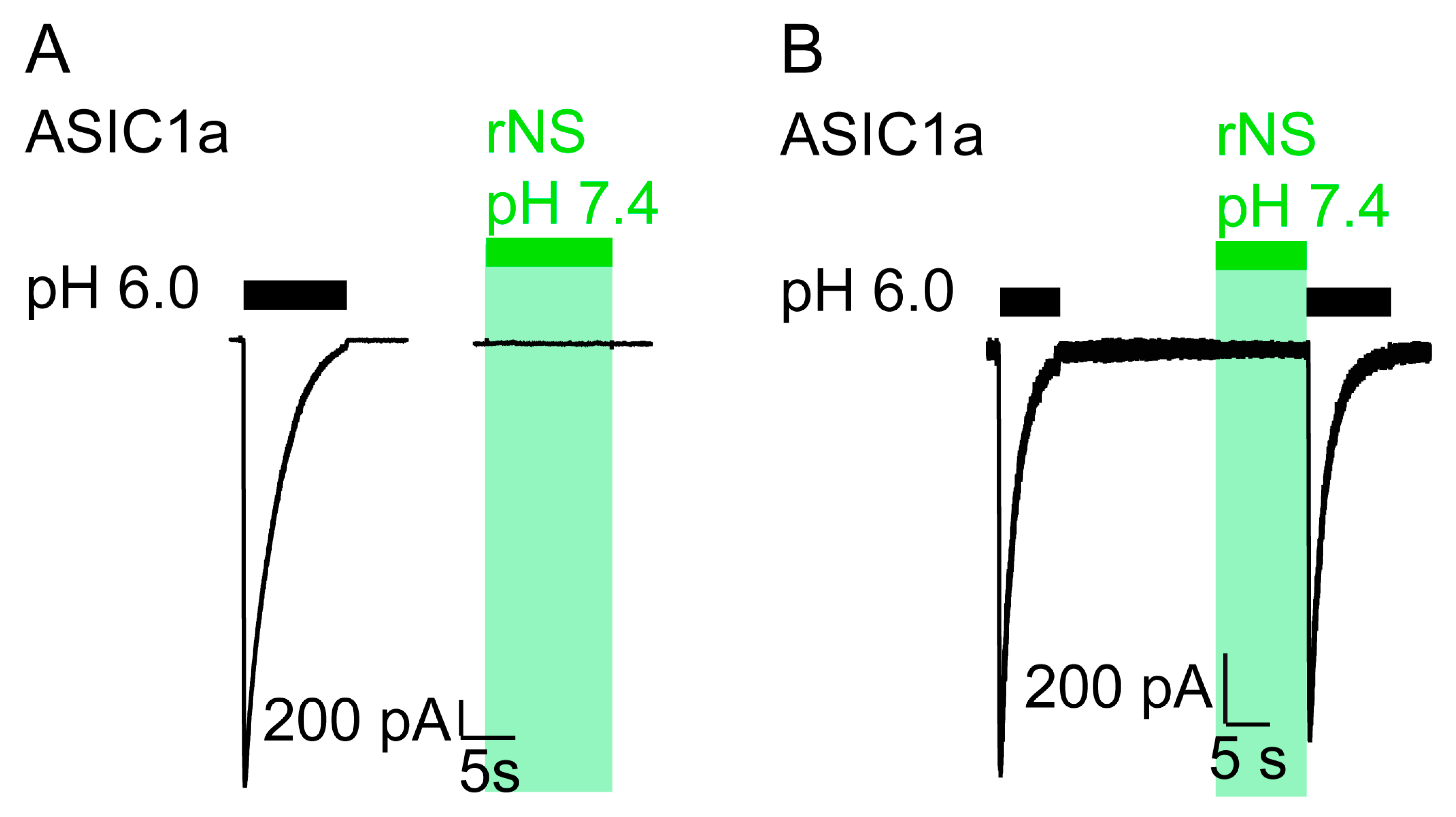The Neuropeptide Nocistatin Is Not a Direct Agonist of Acid-Sensing Ion Channel 1a (ASIC1a)
Abstract
1. Introduction
2. Materials and Methods
2.1. Two Electrode Voltage-Clamp in Xenopus Laevis Oocytes
2.2. Cell Culture and Transfection
2.3. Patch-Clamp Recordings in CHO Cells
2.4. Peptide Synthesis and Handling
3. Results and Discussion
4. Conclusions
Author Contributions
Funding
Institutional Review Board Statement
Informed Consent Statement
Data Availability Statement
Acknowledgments
Conflicts of Interest
References
- Gründer, S. Acid-Sensing Ion Channels. In The Oxford Handbook of Neuronal Ion Channels; Oxford University Press (OUP): Oxford, UK, 2020. [Google Scholar]
- Waldmann, R.; Champigny, G.; Bassilana, F.; Heurteaux, C.; Lazdunski, M. A proton-gated cation channel involved in acid-sensing. Nature 1997, 386, 173–177. [Google Scholar] [CrossRef]
- Gründer, S.; Pusch, M. Biophysical properties of acid-sensing ion channels (ASICs). Neuropharmacology 2015, 94, 9–18. [Google Scholar] [CrossRef] [PubMed]
- Wemmie, J.A.; Askwith, C.C.; Lamani, E.; Cassell, M.D.; Freeman, J.H.; Welsh, M.J. Acid-sensing ion channel 1 is localized in brain regions with high synaptic density and contributes to fear conditioning. J. Neurosci. 2003, 23, 5496–5502. [Google Scholar] [CrossRef] [PubMed]
- Zha, X.M.; Wemmie, J.A.; Green, S.H.; Welsh, M.J. Acid-sensing ion channel 1a is a postsynaptic proton receptor that affects the density of dendritic spines. Proc. Natl. Acad. Sci. USA 2006, 103, 16556–16561. [Google Scholar] [CrossRef] [PubMed]
- Du, J.Y.; Reznikov, L.R.; Price, M.P.; Zha, X.M.; Lu, Y.; Moninger, T.O.; Wemmie, J.A.; Welsh, M.J. Protons are a neurotransmitter that regulates synaptic plasticity in the lateral amygdala. Proc. Natl. Acad. Sci. USA 2014, 111, 8961–8966. [Google Scholar] [CrossRef] [PubMed]
- Gonzalez-Inchauspe, C.; Urbano, F.J.; Di Guilmi, M.N.; Uchitel, O.D. Acid-Sensing Ion Channels Activated by Evoked Released Protons Modulate Synaptic Transmission at the Mouse Calyx of Held Synapse. J. Neurosci. 2017, 37, 2589–2599. [Google Scholar] [CrossRef] [PubMed]
- Kreple, C.J.; Lu, Y.; Taughert, R.J.; Schwager-Gutman, A.L.; Du, J.Y.; Stump, M.; Wang, Y.M.; Ghobbeh, A.; Fan, R.; Cosme, C.V.; et al. Acid-sensing ion channels contribute to synaptic transmission and inhibit cocaine-evoked plasticity. Nat. Neurosci. 2014, 17, 1083–1091. [Google Scholar] [CrossRef] [PubMed]
- Lingueglia, E.; Champigny, G.; Lazdunski, M.; Barbry, P. Cloning of the Amiloride-Sensitive Fmrfamide Peptide-Gated Sodium-Channel. Nat. Cell Biol. 1995, 378, 730–733. [Google Scholar] [CrossRef]
- Assmann, M.; Kuhn, A.; Dürrnagel, S.; Holstein, T.W.; Gründer, S. The comprehensive analysis of DEG/ENaC subunits in Hydra reveals a large variety of peptide-gated channels, potentially involved in neuromuscular transmission. BMC Biol. 2014, 12, 84. [Google Scholar] [CrossRef]
- Schmidt, A.; Bauknecht, P.; Williams, E.A.; Augustinowski, K.; Gründer, S.; Jekely, G. Dual signaling of Wamide myoinhibitory peptides through a peptide-gated channel and a GPCR in Platynereis. FASEB J. 2018, 32, 5338–5349. [Google Scholar] [CrossRef]
- Borg, C.B.; Braun, N.; Heusser, S.A.; Bay, Y.; Weis, D.; Galleano, I.; Lund, C.; Tian, W.H.; Haugaard-Kedstrom, L.M.; Bennett, E.P.; et al. Mechanism and site of action of big dynorphin on ASIC1a. Proc. Natl. Acad. Sci. USA 2020, 117, 7447–7454. [Google Scholar] [CrossRef]
- Sherwood, T.W.; Askwith, C.C. Dynorphin Opioid Peptides Enhance Acid-Sensing Ion Channel 1a Activity and Acidosis-Induced Neuronal Death. J. Neurosci. 2009, 29, 14371–14380. [Google Scholar] [CrossRef] [PubMed]
- Reiners, M.; Margreiter, M.A.; Oslender-Bujotzek, A.; Rossetti, G.; Gründer, S.; Schmidt, A. The Conorfamide RPRFa Stabilizes the Open Conformation of Acid-Sensing Ion Channel 3 via the Nonproton Ligand-Sensing Domain. Mol. Pharmacol. 2018, 94, 1114–1124. [Google Scholar] [CrossRef] [PubMed]
- Askwith, C.C.; Cheng, C.; Ikuma, M.; Benson, C.; Price, M.P.; Welsh, M.J. Neuropeptide FF and FMRFamide potentiate acid-evoked currents from sensory neurons and proton-gated DEG/ENaC channels. Neuron 2000, 26, 133–141. [Google Scholar] [CrossRef]
- Farrag, M.; Drobish, J.K.; Puhl, H.L.; Kim, J.S.; Herold, P.B.; Kaufman, M.P.; Ruiz-Velasco, V. Endomorphins potentiate acid-sensing ion channel currents and enhance the lactic acid-mediated increase in arterial blood pressure: Effects amplified in hindlimb ischaemia. J. Physiol. 2017, 595, 7167–7183. [Google Scholar] [CrossRef]
- Vyvers, A.; Schmidt, A.; Wiemuth, D.; Gründer, S. Screening of 109 neuropeptides on ASICs reveals no direct agonists and dynorphin A, YFMRFamide and endomorphin-1 as modulators. Sci. Rep. 2018, 8, 18000. [Google Scholar] [CrossRef]
- Osmakov, D.I.; Koshelev, S.G.; Ivanov, I.A.; Andreev, Y.A.; Kozlov, S.A. Endogenous Neuropeptide Nocistatin Is a Direct Agonist of Acid-Sensing Ion Channels (ASIC1, ASIC2 and ASIC3). Biomolecules 2019, 9, 401. [Google Scholar] [CrossRef]
- Babini, E.; Paukert, M.; Geisler, H.S.; Gründer, S. Alternative splicing and interaction with di- and polyvalent cations control the dynamic range of acid-sensing ion channel 1 (ASIC1). J. Biol. Chem. 2002, 277, 41597–41603. [Google Scholar] [CrossRef]
- Waldmann, R.; Bassilana, F.; deWeille, J.; Champigny, G.; Heurteaux, C.; Lazdunski, M. Molecular cloning of a non-inactivating proton-gated Na+ channel specific for sensory neurons. J. Biol. Chem. 1997, 272, 20975–20978. [Google Scholar] [CrossRef]
- Bartoi, T.; Augustinowski, K.; Polleichtner, G.; Gründer, S.; Ulbrich, M.H. Acid-sensing ion channel (ASIC) 1a/2a heteromers have a flexible 2:1/1:2 stoichiometry. Proc. Natl. Acad. Sci. USA 2014, 111, 8281–8286. [Google Scholar] [CrossRef]
- Bassilana, F.; Champigny, G.; Waldmann, R.; deWeille, J.R.; Heurteaux, C.; Lazdunski, M. The acid-sensitive ionic channel subunit ASIC and the mammalian degenerin MDEG form a heteromultimeric H+-gated Na+ channel with novel properties. J. Biol. Chem. 1997, 272, 28819–28822. [Google Scholar] [CrossRef] [PubMed]


| Final Concentration of Nocistatin (mM) | Measured pH Value |
|---|---|
| 0.25 | 6.7 |
| 0.5 | 5.1 |
| 1.0 | 4.2 |
Publisher’s Note: MDPI stays neutral with regard to jurisdictional claims in published maps and institutional affiliations. |
© 2021 by the authors. Licensee MDPI, Basel, Switzerland. This article is an open access article distributed under the terms and conditions of the Creative Commons Attribution (CC BY) license (https://creativecommons.org/licenses/by/4.0/).
Share and Cite
Kuspiel, S.; Wiemuth, D.; Gründer, S. The Neuropeptide Nocistatin Is Not a Direct Agonist of Acid-Sensing Ion Channel 1a (ASIC1a). Biomolecules 2021, 11, 571. https://doi.org/10.3390/biom11040571
Kuspiel S, Wiemuth D, Gründer S. The Neuropeptide Nocistatin Is Not a Direct Agonist of Acid-Sensing Ion Channel 1a (ASIC1a). Biomolecules. 2021; 11(4):571. https://doi.org/10.3390/biom11040571
Chicago/Turabian StyleKuspiel, Sven, Dominik Wiemuth, and Stefan Gründer. 2021. "The Neuropeptide Nocistatin Is Not a Direct Agonist of Acid-Sensing Ion Channel 1a (ASIC1a)" Biomolecules 11, no. 4: 571. https://doi.org/10.3390/biom11040571
APA StyleKuspiel, S., Wiemuth, D., & Gründer, S. (2021). The Neuropeptide Nocistatin Is Not a Direct Agonist of Acid-Sensing Ion Channel 1a (ASIC1a). Biomolecules, 11(4), 571. https://doi.org/10.3390/biom11040571






